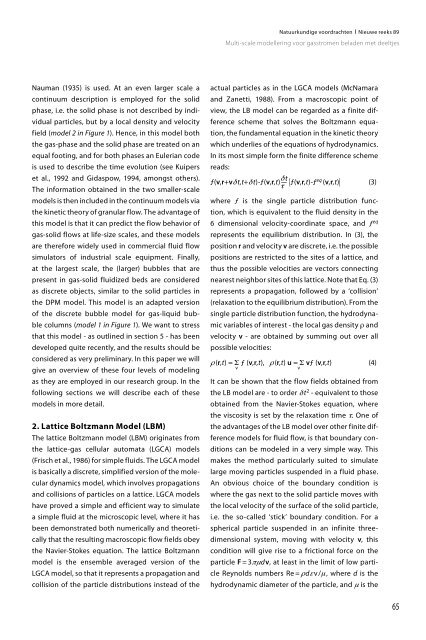Jaarboek no. 89. 2010/2011 - Koninklijke Maatschappij voor ...
Jaarboek no. 89. 2010/2011 - Koninklijke Maatschappij voor ...
Jaarboek no. 89. 2010/2011 - Koninklijke Maatschappij voor ...
Create successful ePaper yourself
Turn your PDF publications into a flip-book with our unique Google optimized e-Paper software.
Nauman (1935) is used. At an even larger scale a<br />
continuum description is employed for the solid<br />
phase, i.e. the solid phase is <strong>no</strong>t described by individual<br />
particles, but by a local density and velocity<br />
field (model 2 in Figure 1). Hence, in this model both<br />
the gas-phase and the solid phase are treated on an<br />
equal footing, and for both phases an Eulerian code<br />
is used to describe the time evolution (see Kuipers<br />
et al., 1992 and Gidaspow, 1994, amongst others).<br />
The information obtained in the two smaller-scale<br />
models is then included in the continuum models via<br />
the kinetic theory of granular flow. The advantage of<br />
this model is that it can predict the flow behavior of<br />
gas-solid flows at life-size scales, and these models<br />
are therefore widely used in commercial fluid flow<br />
simulators of industrial scale equipment. Finally,<br />
at the largest scale, the (larger) bubbles that are<br />
present in gas-solid fluidized beds are considered<br />
as discrete objects, similar to the solid particles in<br />
the DPM model. This model is an adapted version<br />
of the discrete bubble model for gas-liquid bubble<br />
columns (model 1 in Figure 1). We want to stress<br />
that this model - as outlined in section 5 - has been<br />
developed quite recently, and the results should be<br />
considered as very preliminary. In this paper we will<br />
give an overview of these four levels of modeling<br />
as they are employed in our research group. In the<br />
following sections we will describe each of these<br />
models in more detail.<br />
2. Lattice Boltzmann Model (LBM)<br />
The lattice Boltzmann model (LBM) originates from<br />
the lattice-gas cellular automata (LGCA) models<br />
(Frisch et al., 1986) for simple fluids. The LGCA model<br />
is basically a discrete, simplified version of the molecular<br />
dynamics model, which involves propagations<br />
and collisions of particles on a lattice. LGCA models<br />
have proved a simple and efficient way to simulate<br />
a simple fluid at the microscopic level, where it has<br />
been demonstrated both numerically and theoretically<br />
that the resulting macroscopic flow fields obey<br />
the Navier-Stokes equation. The lattice Boltzmann<br />
model is the ensemble averaged version of the<br />
LGCA model, so that it represents a propagation and<br />
collision of the particle distributions instead of the<br />
Natuurkundige <strong>voor</strong>drachten I Nieuwe reeks 89<br />
Multi-scale modellering <strong>voor</strong> gasstromen beladen met deeltjes<br />
actual particles as in the LGCA models (McNamara<br />
and Zanetti, 1988). From a macroscopic point of<br />
view, the LB model can be regarded as a finite difference<br />
scheme that solves the Boltzmann equation,<br />
the fundamental equation in the kinetic theory<br />
which underlies of the equations of hydrodynamics.<br />
In its most simple form the finite difference scheme<br />
reads:<br />
ƒ(v,r+vδ t,t+δ t)-ƒ(v,r,t)δ<br />
t<br />
(ƒ(v,r,t)-ƒ eq t<br />
(v,r,t)) (3)<br />
where ƒ is the single particle distribution function,<br />
which is equivalent to the fluid density in the<br />
6 dimensional velocity-coordinate space, and ƒeq represents the equilibrium distribution. In (3), the<br />
position r and velocity v are discrete, i.e. the possible<br />
positions are restricted to the sites of a lattice, and<br />
thus the possible velocities are vectors connecting<br />
nearest neighbor sites of this lattice. Note that Eq. (3)<br />
represents a propagation, followed by a ‘collision’<br />
(relaxation to the equilibrium distribution). From the<br />
single particle distribution function, the hydrodynamic<br />
variables of interest - the local gas density r and<br />
velocity v - are obtained by summing out over all<br />
possible velocities:<br />
r (r,t) = Σ ƒ (v,r,t), r (r,t) u = Σ vƒ (v,r,t) (4)<br />
v v<br />
It can be shown that the flow fields obtained from<br />
the LB model are - to order δ t 2 - equivalent to those<br />
obtained from the Navier-Stokes equation, where<br />
the viscosity is set by the relaxation time t. One of<br />
the advantages of the LB model over other finite difference<br />
models for fluid flow, is that boundary conditions<br />
can be modeled in a very simple way. This<br />
makes the method particularly suited to simulate<br />
large moving particles suspended in a fluid phase.<br />
An obvious choice of the boundary condition is<br />
where the gas next to the solid particle moves with<br />
the local velocity of the surface of the solid particle,<br />
i.e. the so-called ‘stick’ boundary condition. For a<br />
spherical particle suspended in an infinite threedimensional<br />
system, moving with velocity v, this<br />
condition will give rise to a frictional force on the<br />
particle F = 3πmdv, at least in the limit of low particle<br />
Rey<strong>no</strong>lds numbers Re = rdε v /m , where d is the<br />
hydrodynamic diameter of the particle, and m is the<br />
65




